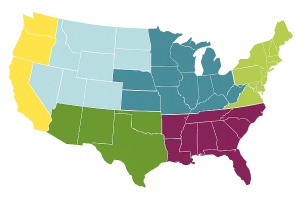Maine Native Plants, State Flower & State Bird
Posted By American Meadows Content Team on Sep 27, 2012 · Revised on Oct 26, 2025

Knowing your location helps us recommend plants that will thrive in your climate, based on your Growing Zone.
Posted By American Meadows Content Team on Sep 27, 2012 · Revised on Oct 26, 2025
Native plants are adaptable, low-maintenance, and beautiful. They are the best choice for habitat-friendly gardens and thriving ecosystems. Find top picks for native plants in your state - and learn about your state bird and state flowers!
Follow Along With More Of Our Guides
Hello native plant enthusiasts! In the list below, you will find popular native plants and wildflower seeds, available from American Meadows, that have a native distribution in your state. You’ll also find information about your state bird, state flower, and state wildflower!
Grow our Native Northeast Wildflower Seed Mix
Virginia Bluebells (Mertensia virginica)
Wrinkleleaf Goldenrod (Solidago rugosa)
Perennial Lupine (Lupinus perennis)
Black Eyed Susan or Gloriosa Daisy (Rudbeckia hirta)
Pale Purple Coneflower (Echinacea pallida)
Butterfly Weed (Asclepias tuberosa)
Swamp Milkweed (Asclepias incarnata)
Common Milkweed (Asclepias syriaca)
White Trillium (Trillium grandiflorum)
Red Trillium (Trillium erectum)
Painted Trillium (Trillium undulatum)
Long Beaked Sedge (Carex sprengelii)
White Tinged Sedge (Carex albicans)
Appalachian Sedge (Carex appalachica)
Yellow Prairie Grass (Sorghastrum nutans)
Wild Strawberry (Fragaria virginiana)
Lowbush Blueberry (Vaccinium angustifolium)
Lanceleaf Coreopsis (Coreopsis lanceolata)
Wild Bergamot (Monarda fistulosa)
Wild Geranium (Geranium maculatum)
Elderberry (Sambucus canadensis)
Phlox subulata (Creeping Phlox)
Obedient Plant (Physostegia virginiana)
Red Cardinal Flower (Lobelia cardinalis)
Meadow Anemone (Anemone canadensis)
Lacy Phacelia (Phacelia tanacetifolia)
Bottlebrush Grass (Elymus hystrix)
Big Bluestem (Andropogon gerardii)
Little Bluestem (Schizachyrium scoparium)
Tufted Hair Grass (Deschampsia cespitosa)
Smooth Blue Aster (Symphyotrichum laeve)
New England Aster (Symphyotrichum novae-angliae)
Common White Yarrow (Achillea millefolium)
Heliopsis (Heliopsis helianthoides)

Chickadee ~ Parus atricapillus
This gentle little bird takes its name from its clearly spoken call note, chick-a-dee-dee-dee. With the coming of spring it also whistles a high-pitched fee-bee. Chickadees are year-round residents in Maine. They rove the winter woodlands in small flocks, examining bark, twigs, and branches for spider eggs, cocoons, and other dormant insect life. This Chickadee can easily be distinguished from the other, small birds. Their white cheeks shine out, separating the solid black cap above from the fringed black bib below.
White Pine Cone and Tassel ~ Pinus strobus
The White Pine Cone and Tassel grows on the White Pine, a beautiful evergreen tree which grows rapidly and sometimes reaches a height of two hundred feet. Through centuries of evolution, the White Pine's leaves have changed to three-sided needles. The strongest of winds cannot harm them. In fact, wind is necessary to pines and to many other trees, for it scatters pollen grains. The White Pine Cone lacks the lovely color and the sheer beauty of some flowers. Yet, the White Pine Cone and Tassel magnificently reflects Maine's stern climate, her rugged soil, and her independent people.
From The Wildflowers of the 50 States U.S. stamps issued July 24, 1992:

